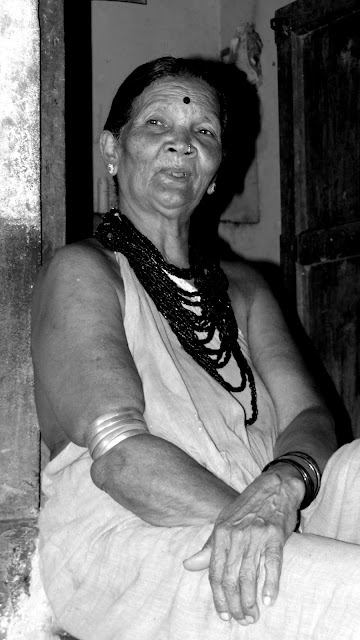They are simple but gorgeous, wear heavy jewellery but look graceful, are lively and lovely women. The Halakki Vokkaliga community, a distinct tribal group of Uttara Kannada district that live near the foothills of Western Ghats, has its own unique culture and tradition.
 |
| Halakki Gowdati. Wrinkles on her face contrast with the smooth beads she adores around her neck. |
The Halakki women are innocent, hardworkn and kind hearteThe Halakki women are innocent, hardworkn and kind hearted. They have their own distinct identity. Tanned skin and slim physique speak about their hard work.
Six or more layers of bead necklaces, metal bangles on arms, very unique way of wearing sarees, big nose studs, pan stained teeth and lips - these are the special identities of Halakki women which make them stand out in the crowd.
 |
Halakki women wear metal armlets on
their lower arms above the elbow. These bangles are generally made of brass and
are wider than the normal bangles women wear.
|
According to Dr. L. G. Bhat, who has worked extensively on the tradition and culture of Halakki community, the word ‘Halakki’ might have originated from a wedding ritual of Havyaka Brahmin community. The Halakkis, who lead the wedding procession, have a special privilege of sprinkling milk and rice (called haalu and akki in Kannada) to please the ghosts.
 |
It’s their routine and not festive look!
Burden of beads!! How comfortably women
work in spite of heavy jewellery!!
|
 |
Eye catching layers of beads. As
Traditional so Modern!
|
 |
| Halakki Gowdati is proudly showing her beads. Very tiny yellow beads line entangled with yellow-black line to give a good contrast. The little one is wondering. |
 |
For city girls these beads necklaces are
a fashion. They are in great demand. They go well with traditional as well as
modern outfits.
|
 |
| Two girls in Halakki get up! Striking a pose and appreciating each other’s look. |
During our recent visit to Halakki colonies, we met Halakki Gowda (male head of Halakki family) and Gowdati (female head of Halakki family) and had a casual chat with them. We found the older generation of women are very proud of their attire and culture and very few women follow the traditional dressing.
 |
| Wonder how did she wear them? She smiled, ‘not a problem. I use soap remove the armlets whenever I want to wash them and again with the help of soap I again wear them’ |
With the changing societies and community needs one has to change the lifestyle, but should not forget the tradition and identity. The younger generation cannot follow the traditional Halakki dressing style for obvious reasons. The vanishing Halakki culture can be preserved only if they follow on special occasions like festivities and wedding celebrations.
 |
Row of colourful bead malas on sale.
Look at the variety!
|

